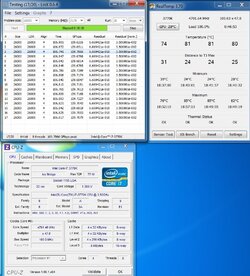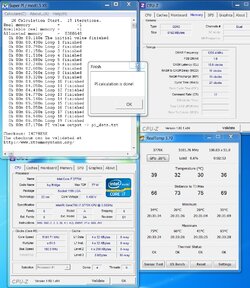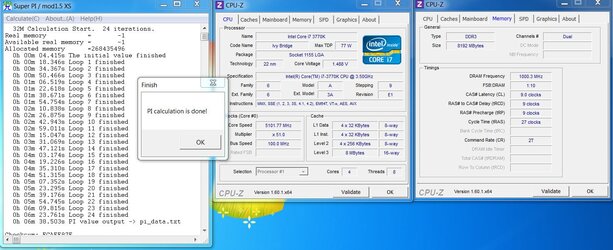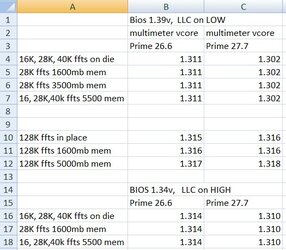- Joined
- Nov 3, 2008
got a screen shot of IBT at max on your oc,with the specs just so i can compare

I have no idea why it was reading 4.4 in Core temp it was clocked at 4.4. This is from a set voltage run.
Welcome to Overclockers Forums! Join us to reply in threads, receive reduced ads, and to customize your site experience!
got a screen shot of IBT at max on your oc,with the specs just so i can compare

IBT max 4.7G 1.375V LLC 75% 16GB 9-11-11-28-1t max core 83c
View attachment 110826
are you using prime 2.77? and do you test with IBT at max,i needed i think for 4.6 think it was 1.25v LLC 75%

rge, what I am seeing with my 3570K at 4.8 is looking much like thermal instability. 4.7 isn't too much a problem getting stable (so far) but 4.8 is a totally different story. Like you, I am seeing the need for a much greater bump in vcore, which then compounds the heat problem with the processor due to Intel using a very inferior TIM between die and IHS. It seems like I can almost get it stable, but then temps climb and stability goes down the crapper yet again. I even tried up to 1.43 vcore (under load) and using a pretty decent loop for cooling and last P95 run I tried at that setting locked up sometimes after Core 1 hit the 100 C mark. With the crappy TIM they are using, there is just no way to effectively cool IB (ambient cooling) once it hits the spot where vcore starts ramping quickly. And that is different from what I see with my 2500K. I was using it at 4.7 as a 24/7 clock, but I can get well past 5.0 when benching with acceptable temps and stability. Also, I am seeing that with my 3570K and my 3770K, vcores when overclocking to past 4.5 run no lower than what I was having to use with my 2500K and 1 of my 2600K procs. I am thinking that Intel needs to spin through a few more steppings to refine 22 nm before we see decent ambient results on this process.
yep, prime 27.7 for stability used it first, also ran 26.6 just to put in database on one forum that for unclear reasons is using 26.6, and can decrease vcore 2 notches and still be stable with 26.6 and no whea erros. I can run 27.7 at 2 notches below 1.314 for 15hrs, but get whea errors, had 8, 5 of them on 40kffts run. 2 notches higher at 1.314 real load, I get no whea errors on 40k ffts, then easily passed 27.7 again with no whea errors. Now i use 40kffts and look at whea errors for screening stability before long runs.
yep, I ran 4.7 with linx 5gb mem, I use 1gb less than max free, here is pic at load near end. I have 8 gb ram. But I can run linx at lower vcore than prime 27.7, mainly because linx doesnt seem to generate whea erros.
nice oc mine wont do that,what do you have your memory running at?


105C is the max... keep it below that however.
Well I think I have made my decision as it pertains to the IB CPU.
We got used to easy, high and relatively cool overclocking with the Sandy Bridge. Comparing this to Sandy Bridge is almost like comparing the BD to the PhII x6. If you have a SB don't upgrade unless you can use the extra features or you dont OC.
I got mine because I needed it not because I wanted it and though it was, is and will be fun to play with, it is still a little anticlimactic.
So I think those who live off of the IGP or game a bit with GFX bound games could make use of it and but as a replacement CPU it is not worth the money unless you want a challenging OC.
Just my two cents.
Upgrade? NO! Not for anything over a 2500K until the low power model duals and single core celery hit then the game changes. At stock this is the better of the two any day and those benefits may be a win for IB in the SFF/HTPC sector.
New purchase for non extreme overclocking? Yes and no, because you will get better performance at stock clocks all the way up to the limit which seems to be 1-500 less on air with reasonable temperatures. So 4.4-4.6 seems to be the max due to the temps on air.
New purchase for not overclocking? Yes and yes.
Well I think I have made my decision as it pertains to the IB CPU.
We got used to easy, high and relatively cool overclocking with the Sandy Bridge. Comparing this to Sandy Bridge is almost like comparing the BD to the PhII x6. If you have a SB don't upgrade unless you can use the extra features or you dont OC.
I got mine because I needed it not because I wanted it and though it was, is and will be fun to play with, it is still a little anticlimactic.
So I think those who live off of the IGP or game a bit with GFX bound games could make use of it and but as a replacement CPU it is not worth the money unless you want a challenging OC.
Just my two cents.
Upgrade? NO! Not for anything over a 2500K until the low power model duals and single core celery hit then the game changes. At stock this is the better of the two any day and those benefits may be a win for IB in the SFF/HTPC sector.
New purchase for non extreme overclocking? Yes and no, because you will get better performance at stock clocks all the way up to the limit which seems to be 1-500 less on air with reasonable temperatures. So 4.4-4.6 seems to be the max due to the temps on air.
New purchase for not overclocking? Yes and yes.
I agree with your first and last statements, but not the one about new buyers. Even if you plan on being an OCer, Ivy is worth it. Yes, it's true, you cannot take it clock for clock as high as Sandy, but the performance difference works out in the end. And with Ivy you have additional benefits, and may very well have a more resilient chip.
Absolutely wouldn't recommend an upgrade from Sandy, but I would say any new buyer whether they are an OCer or not might as well just get it. Especially if you live by a Microcenter
The consensus seems to be that if you already have SB, going to IB is probably not a worthwhile upgrade. If you have something older, there's really no reason not to go with IB. I just upgraded my Q6600 system to a 3770K and I am very happy with it.I have been debating and researching this topic and found to get the IB over the SB. I am building my first rig and want to OC. So are you saying to get the SB?
I have been debating and researching this topic and found to get the IB over the SB. I am building my first rig and want to OC. So are you saying to get the SB?
Thanks!The consensus seems to be that if you already have SB, going to IB is probably not a worthwhile upgrade. If you have something older, there's really no reason not to go with IB. I just upgraded my Q6600 system to a 3770K and I am very happy with it.
No I am saying it is not worth it to upgrade from SB if you want to high air OG unless it has features you really need. If I had to buy new I would get IB but if I were looking at replacing my 2500K I would wait until gets the issues worked out as far as heat and the like or even skip this generation all together.
Ivy is better than SB there is no doubt and unless you want to go for a high OC IB is the way to go.

